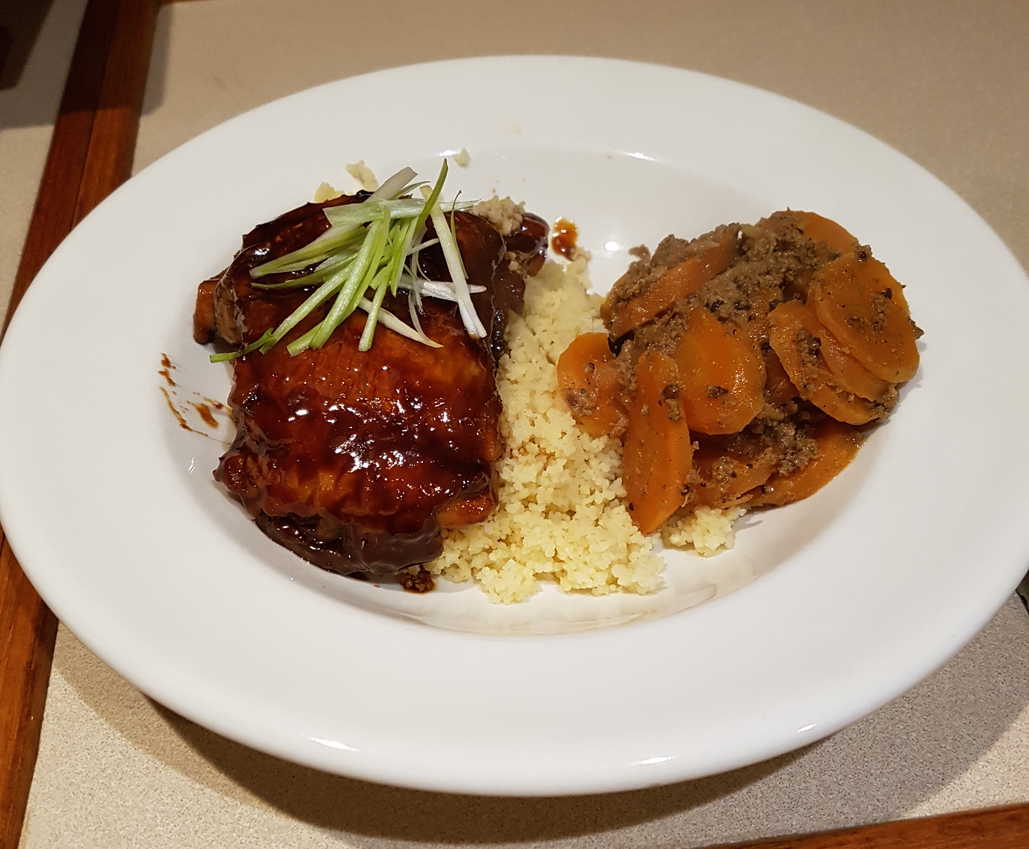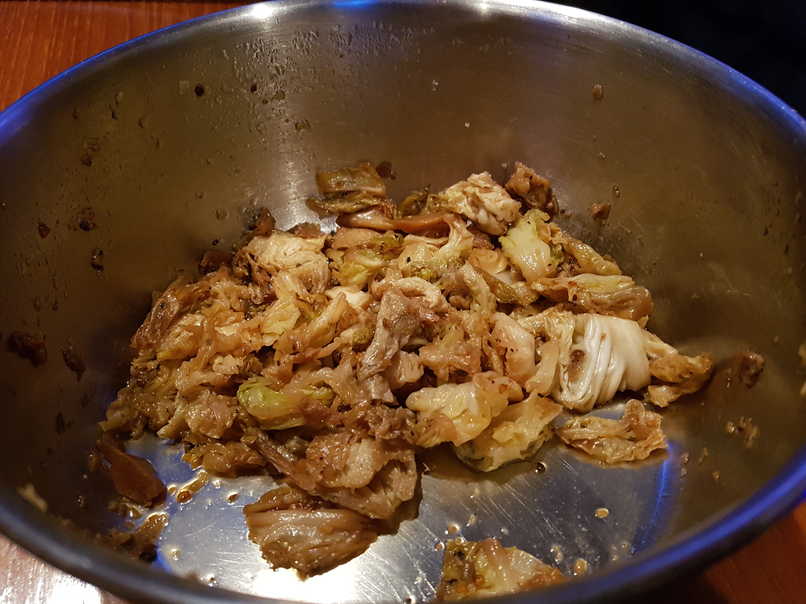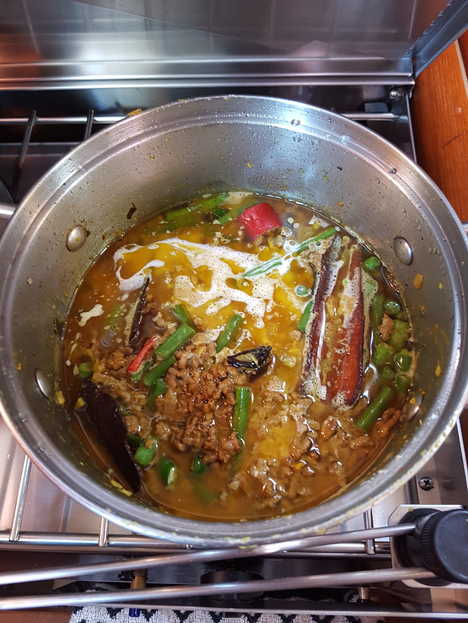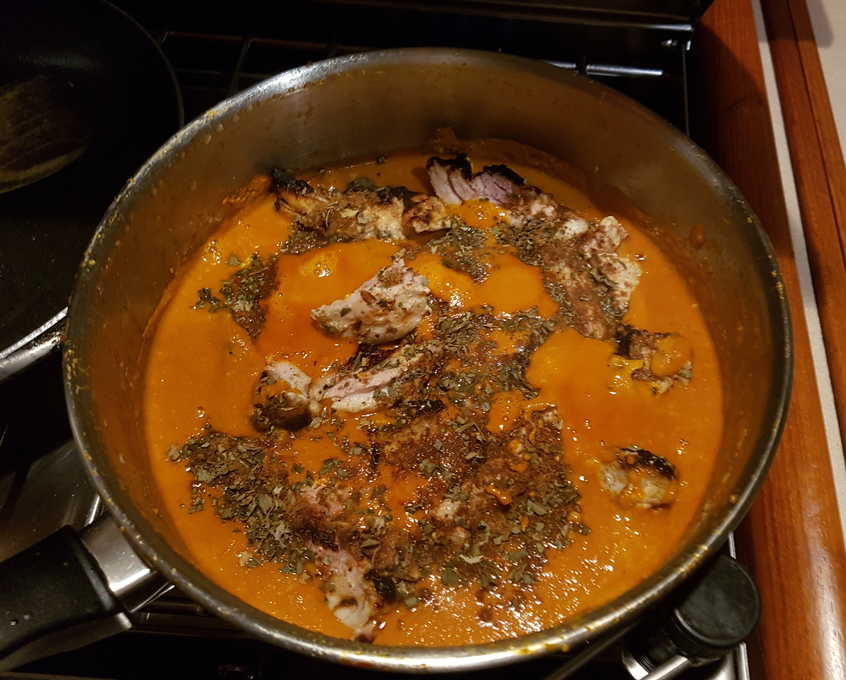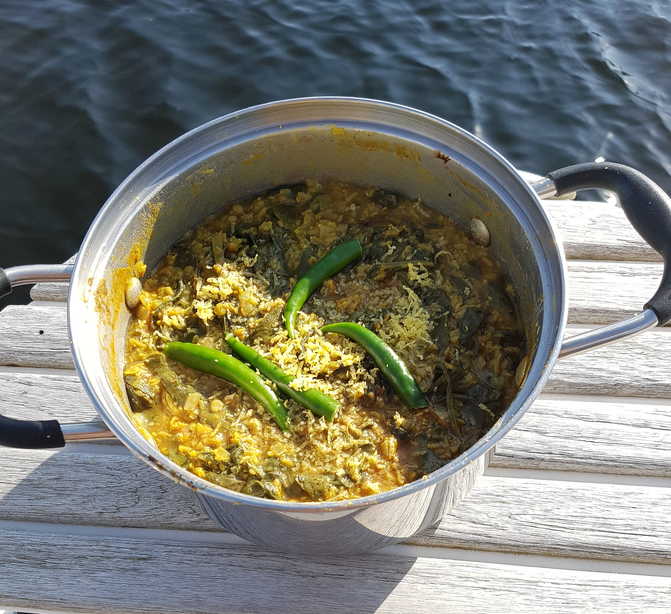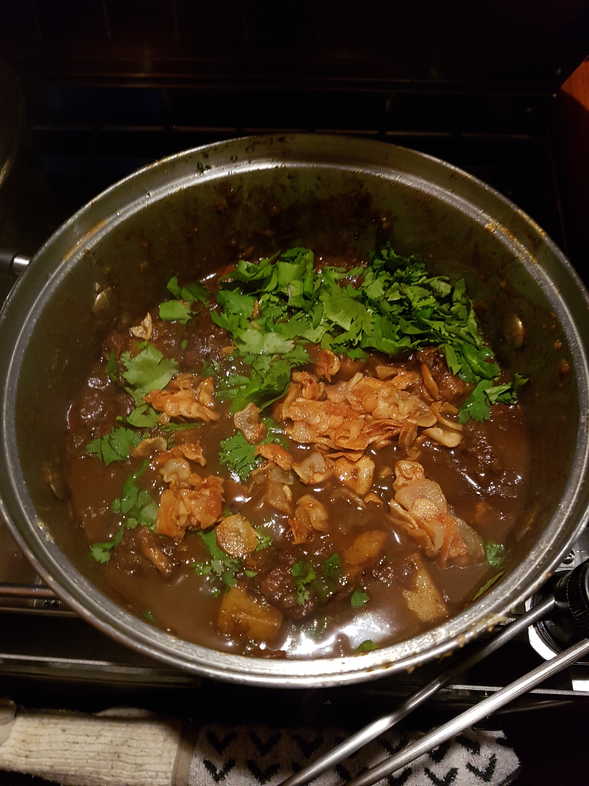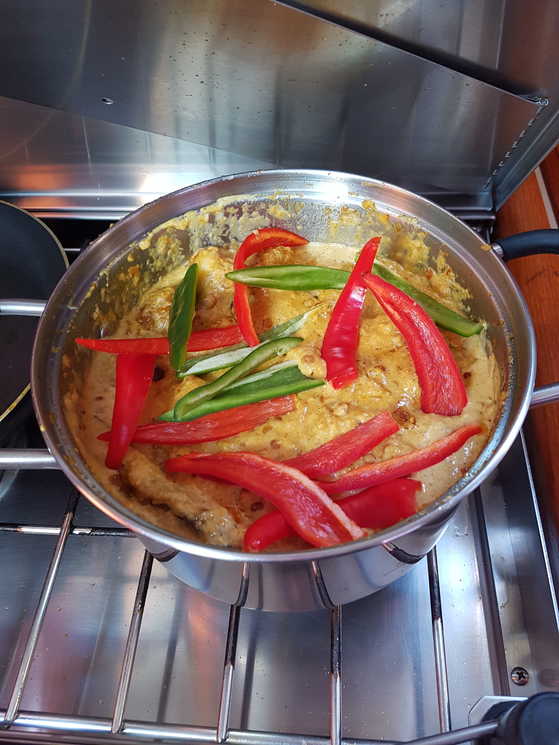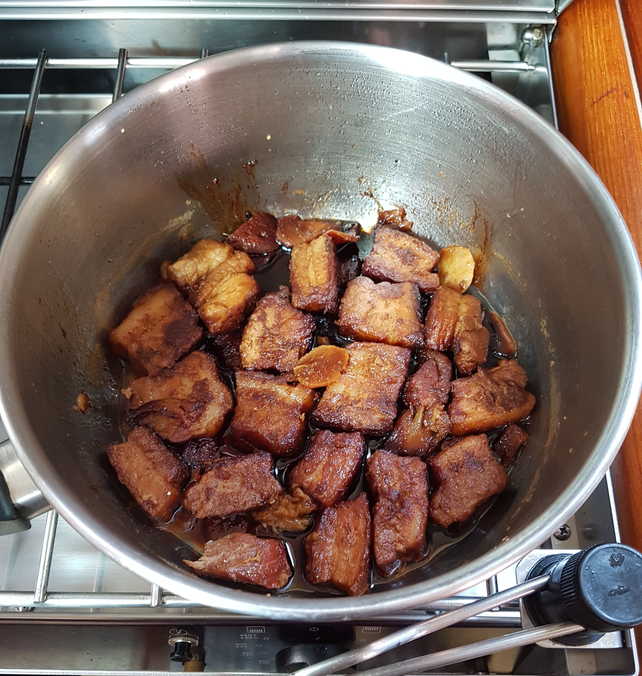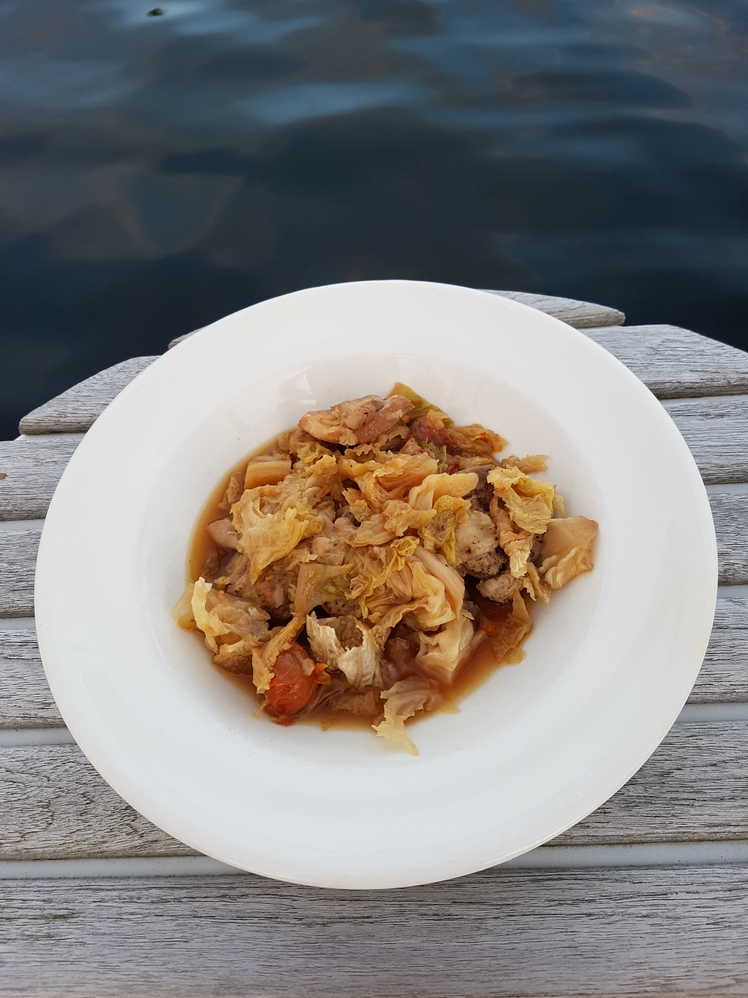
Lockdown Lūʻau

Gosh, the lockdown party never ends here at the Royal Quays Marina.
I discovered a new un-recipes website featuring mostly Japanese, oriental and some Hawaiian dishes. So it's a curry Lūʻau!
Which is ideal for someone now cooking on a Universal Credit budget - prepare to be underwhelmed...
Teriyaki Chicken
oriental fowl main
Marc Matsumoto, the original author of this recipe
is emphatic about the ingredients of a traditional teriyaki sauce not including
ginger, garlic, spring onions, fruit juice, sesame oil or any other trendy modern crap.
It's supposed to be a simple, shiny glaze consisting only of soy sauce, sugar and sake.
You can use brown or cane sugar for preference, and apparently adding some rice maltose makes for an even shinier result.
You can use brown or cane sugar for preference, and apparently adding some rice maltose makes for an even shinier result.
Though another site also claiming Japanese authenticity uses equal amounts of soy sauce, sake, and mirin.
With sugar to taste.
Which produces as good a result, I'd say.
You can also grill the chicken, boiling up the sauce separately and using it to baste the cooked chicken at the end to get the same shiny glaze.
Serves 3-4
Ingredients
- ½kg skin-on boneless chicken thighs (4-6 large chicken thighs)
- ¼ teaspoon salt
- 2 tablespoons soy sauce
- 2 tablespoons sugar
- 2 tablespoons sake
Sprinkle both sides of the chicken evenly with the salt and set aside until the salt draws out some moisture from the chicken.
Use paper towels to pat the chicken thoroughly dry.
Place the chicken skin-side down in a cold non-stick frying pan and turn the heat on to medium. If you are using skinless chicken, you will need to add a bit of oil to the pan.
Fry the chicken on one side until the skin is crisp and browned. Flip the chicken over and continue frying until the chicken is almost cooked through.
Remove the chicken and pat dry with paper towels. Pour remaining oil out of the pan and clean off with more towels.
Add the soy sauce, sugar and sake to the pan and turn the heat up to high. Once bubbling add back the chicken and use tongs to continuously flip the pieces to keep basting them with the teriyaki sauce.
The chicken teriyaki is done when there is almost no liquid remaining in the pan, and the chicken is coated in a thick, shiny glaze.
Place the chicken skin-side down in a cold non-stick frying pan and turn the heat on to medium. If you are using skinless chicken, you will need to add a bit of oil to the pan.
Fry the chicken on one side until the skin is crisp and browned. Flip the chicken over and continue frying until the chicken is almost cooked through.
Remove the chicken and pat dry with paper towels. Pour remaining oil out of the pan and clean off with more towels.
Add the soy sauce, sugar and sake to the pan and turn the heat up to high. Once bubbling add back the chicken and use tongs to continuously flip the pieces to keep basting them with the teriyaki sauce.
The chicken teriyaki is done when there is almost no liquid remaining in the pan, and the chicken is coated in a thick, shiny glaze.
Now you can add that delicious modern western crap like a scattering of shredded spring onions, a bit of fruit or a drizzle of sesame oil.
Chicken and Cabbage Stew
main fowl stew
This non-oriental No Recipe recipe by Marc Matsumoto
involves a lot of chopping, especially if you're starting with chicken thighs on the bone which you will need to strip,
but it's pretty easy, and you can work while the stages cook so you don't need to prepare everything ahead of time.
Serves 4
Ingredients
- 500g boneless skin-on chicken thighs
- ½ tsp salt
- ½ tsp ground black pepper
- 200g bacon, chopped
- 6 cloves garlic, sliced
- 1 onion, sliced
- 350g small tomatoes
- couple bay leaves
- 10 juniper berries, lightly crushed optional
- 500g cabbage (a small head), roughly chopped
- a glass of sherry or wine
- 2 tblsps soy sauce
Cut the chicken into bite-size pieces and sprinkle evenly with the salt and pepper. Set aside for an hour or while you prepare the other ingredients.
Chop the bacon (offcuts are ideal) into ½ chunks and put in a dutch oven or heavy pan with a little olive oil and fry over medium heat until some fat begins to render out (you do not need to crisp the bacon).
Add the onions then the garlic and saute until the onions are soft and the garlic starts to brown.
Stir in the crushed juniper berries. Add the bay leaves and the whole tomatoes and stir to distribute evenly.
Chop the cabbage into hefty chunks and add half in a flat layer.
Add the seasoned chicken pieces in a single layer.
Top with the remaining cabbage and drizzle the sherry and soy sauce over the cabbage. I also simmered up the chicken thigh bones in a little water and added this stock.
Cover securely with a lid and bring to a boil, and then reduce the heat to low. Gently simmer until the chicken is tender (about 30 minutes).
Remove the lid and stir to evenly distribute all the components, taste it and add salt and pepper as needed. Serve the chicken stew with crusty bread or buttery mash.
Chop the bacon (offcuts are ideal) into ½ chunks and put in a dutch oven or heavy pan with a little olive oil and fry over medium heat until some fat begins to render out (you do not need to crisp the bacon).
Add the onions then the garlic and saute until the onions are soft and the garlic starts to brown.
Stir in the crushed juniper berries. Add the bay leaves and the whole tomatoes and stir to distribute evenly.
Chop the cabbage into hefty chunks and add half in a flat layer.
Add the seasoned chicken pieces in a single layer.
Top with the remaining cabbage and drizzle the sherry and soy sauce over the cabbage. I also simmered up the chicken thigh bones in a little water and added this stock.
Cover securely with a lid and bring to a boil, and then reduce the heat to low. Gently simmer until the chicken is tender (about 30 minutes).
Remove the lid and stir to evenly distribute all the components, taste it and add salt and pepper as needed. Serve the chicken stew with crusty bread or buttery mash.
The result ain't bad! The soy sauce adds welcome depth to an otherwise quite bland stew.
Szechuan Cabbage
oriental veg side
Also known as Sichuan.
Serves 2
Ingredients
- 1 medium-sized cabbage, chopped or torn
- vegetable cooking oil
- 2-4 garlic cloves, sliced
- 1-2 inch root ginger, minced
- 3 to 6 dried chilli peppers
- 1 teaspoon Sichuan peppercorn seeds, lightly crushed
- 1 tablespoon light soy sauce
- ½ tablespoon black vinegar
- ½ teaspoon salt if needed
Separate the cabbage leaves and cut out their stalks. You can discard the stalks or slice them up to include.
Tear up the leaves, or cut them roughly with a knife if you can't be bothered.
Lightly crush the Szechuan peppercorns in a mortar.
Cut up the chillies with scissors into 2" lengths if they're long.
Peel and mince the ginger, and slice the garlic.
Heat oil in a wok or a large pan and add the peppercorns and chillies. Fry over a low heat until fragrant.
Add the ginger and garlic and fry gently until fragrant.
Turn up the heat to medium. Add the cabbage stalks, if using and fry until they soften a little. Add the cabbage leaves and fry quickly, turning, then add the soy sauce and black vinegar. Stir to coat the cabbage over high heat, season if necessary, and serve.
Lightly crush the Szechuan peppercorns in a mortar.
Cut up the chillies with scissors into 2" lengths if they're long.
Peel and mince the ginger, and slice the garlic.
Heat oil in a wok or a large pan and add the peppercorns and chillies. Fry over a low heat until fragrant.
Add the ginger and garlic and fry gently until fragrant.
Turn up the heat to medium. Add the cabbage stalks, if using and fry until they soften a little. Add the cabbage leaves and fry quickly, turning, then add the soy sauce and black vinegar. Stir to coat the cabbage over high heat, season if necessary, and serve.
Pretty nice. Traditionally this would use napa cabbage, but it works just fine with a savoy.
Keema Curry with Coconut Cream
curry meat main
My Local Fucking Supermarket™ had beef mince (Less than 20% fat!!) on offer, and I couldn't resist.
Since I was already making a load of curries I wanted one of a different character, fancied an Indian curry with coconut cream, but couldn't find a recipe.
So I made one up.
Since I was already making a load of curries I wanted one of a different character, fancied an Indian curry with coconut cream, but couldn't find a recipe.
So I made one up.
Serves 4
Ingredients
- 500g beef mince FULL FUCKING FAT!
- oil or ghee
- 2 black cardamoms
- 6 green cardamoms
- couple sticks cassia bark
- 6 cloves
- 1 teaspoon fenugreek seeds
- 1 tblsp roughly crushed curry leaves
- 2" ginger minced
- 6 cloves garlic, minced
- 1 onion, finely chopped
- 1-2 tblsps vinegar I used malt
- 1 tsp cumin powder
- 1 tsp chilli powder
- 2 tsps coriander powder
- 1 teaspoon freshly ground black pepper
- 1 tsp salt
- 1 tsp turmeric powder
- 3 tblsps yoghurt
- 200g fine green beans or probably peas
- half a dozen fresh chillies red would be good, cut into fat rounds
- 1 tin coconut cream
Heat a generous amount of oil or ghee in a pan and fry the cardamoms, cassia and cloves until they swell and become fragrant.
Add the fenugreek seeds, then the crushed curry leaves. Let them fizz for a few seconds.
Add the mince in batches so as not to overload the pan and fry until the meat begins to brown. Scoop out the meat with a slotted spoon and set aside.
Mix the spice powders with the vinegar and a little water if necessary to make a thick paste. Reheat the pan with more oil if necessary and add the minced ginger and fry, stirring, until the ginger begins to lightly colour. Add the chopped onion and fry, stirring, until it begins to caramelise around the edges. Add the minced garlic and fry for a minute then add the spice paste. Fry until the oil separates and the paste loses any harshness.
Stir in the yoghurt and fry gently until it thickens.
Return the meat to the pan, add the coconut cream and stir thoroughly. Simmer gently for 15 minutes or so until the cream begins to reduce a little and thicken. Chop the green beans into 1-2" pieces and the chillies into fat rounds and add to the pan. Continue to cook for a few minutes until the beans are tender.
Dress with fresh coriander and serve.
Add the mince in batches so as not to overload the pan and fry until the meat begins to brown. Scoop out the meat with a slotted spoon and set aside.
Mix the spice powders with the vinegar and a little water if necessary to make a thick paste. Reheat the pan with more oil if necessary and add the minced ginger and fry, stirring, until the ginger begins to lightly colour. Add the chopped onion and fry, stirring, until it begins to caramelise around the edges. Add the minced garlic and fry for a minute then add the spice paste. Fry until the oil separates and the paste loses any harshness.
Stir in the yoghurt and fry gently until it thickens.
Return the meat to the pan, add the coconut cream and stir thoroughly. Simmer gently for 15 minutes or so until the cream begins to reduce a little and thicken. Chop the green beans into 1-2" pieces and the chillies into fat rounds and add to the pan. Continue to cook for a few minutes until the beans are tender.
Dress with fresh coriander and serve.
Not too dusty!
I made mine too watery by adding liquid and simmering before adding the coconut cream. So don't do that.
I made mine too watery by adding liquid and simmering before adding the coconut cream. So don't do that.
Butter Chicken
curry fowl main
Tweaking Marc Matsumoto's recipe
by boosting the garlic and ginger and adding lemon juice and a little more yoghurt.
Serves 4
Ingredients
- 6 cloves garlic
- 2" fresh ginger
- 1-3 fresh chillies, de-seeded
- 500g boneless skinless chicken thighs
- 200g plain yogurt
- juice of 1 lemon
- 1 tblsp vegetable oil
- 1 teaspoon salt
- 1 teaspoon garam masala
- 1/4 teaspoon saffron (threads crushed)
- 600 grams (1½ tins) whole stewed tomatoes
- 2 tablespoons tomato paste
- 3 tablespoons cultured unsalted butter
- 6 pods green cardamom
- 1 pod black cardamom
- 1 cinnamon stick
- 4 cloves
- 1 teaspoon fenugreek seeds
- 2 fresh chili peppers
- 40 grams raw cashew nuts (about 1/4 cup)
- 1 teaspoon salt (to taste)
- 1 teaspoon dried fenugreek leaves (qasuri methi)
- 1 teaspoon garam masala
- 100ml heavy cream
Purée the ginger, garlic and chillies, you may need to add a bit of water to make it go.
In a small bowl, whisk the yogurt, vegetable oil, salt, garam masala, saffron, lemon juice and 1-2 tablespoons of the garlic ginger mixture together. Save the remaining garlic ginger mixture for the sauce.
Put the chicken in a freezer bag and pour the marinade all over it, rubbing it into the chicken. Squeeze all the air out of the bag and seal it. Marinate for at least 4 hours or preferably overnight.
For the sauce, purée the stewed tomatoes with their juices in a blender or food processor.
Heat the butter in a pot along with the green cardamom, black cardamom, cinnamon and cloves. Fry the mixture until the cloves are puffy. Add the fenugreek seeds and fry for a few seconds, then add the chili peppers, and remaining garlic ginger mixture and saute until browned, and very fragrant.
While the tomatoes are reducing, grill the chicken. You can use either an outdoor grill or broiler or you can just roast them in the (very hot) oven, but in either case it needs to be very hot. You want to get the outside lightly charred, but you don't want to cook the chicken all the way through as it will finish cooking in the sauce. If you cook it completely now, it will get overcooked in the sauce.
Transfer the chicken to a cutting board and let it rest for at least 10 minutes before cutting.
In a blender or food processor, add the raw cashew nuts along with 2 cups of water. Puree until smooth and milk-like in color.
When the tomato mixture is done caramelizing turn off the heat and add the cashew nut milk, whisking it together.
Pass the sauce through a wire strainer into a saucepan, pressing on the solids with a silicone spatula to get as much sauce through as you can.
Add the cream and stir together and then turn the heat off. Plate the butter chicken and drizzle a little extra cream on top. Garnish with some cilantro leaves.
In a small bowl, whisk the yogurt, vegetable oil, salt, garam masala, saffron, lemon juice and 1-2 tablespoons of the garlic ginger mixture together. Save the remaining garlic ginger mixture for the sauce.
I screwed up and used all the garlic/ginger in the marinade then had to make up more. It didn't seem to hurt any.
I might have added a teaspoon of smoked paprika to the marinade too.
I might have added a teaspoon of smoked paprika to the marinade too.
Put the chicken in a freezer bag and pour the marinade all over it, rubbing it into the chicken. Squeeze all the air out of the bag and seal it. Marinate for at least 4 hours or preferably overnight.
For the sauce, purée the stewed tomatoes with their juices in a blender or food processor.
Heat the butter in a pot along with the green cardamom, black cardamom, cinnamon and cloves. Fry the mixture until the cloves are puffy. Add the fenugreek seeds and fry for a few seconds, then add the chili peppers, and remaining garlic ginger mixture and saute until browned, and very fragrant.
Actually I don't think you can get butter hot enough to fry whole spices without burning it so I used oil here (ghee would be better)
and whisked butter into the sauce later.
Add the tomato paste and fry until the oil separates.
Add the pureed stewed tomatoes and cook this mixture over medium heat until the tomatoes have become very thick and paste-like (about 45 minutes).
Once the mixture starts sputtering you'll want to stir it pretty regularly
to keep the sputtering under control while maintaining enough heat to reduce the liquid.While the tomatoes are reducing, grill the chicken. You can use either an outdoor grill or broiler or you can just roast them in the (very hot) oven, but in either case it needs to be very hot. You want to get the outside lightly charred, but you don't want to cook the chicken all the way through as it will finish cooking in the sauce. If you cook it completely now, it will get overcooked in the sauce.
I used a British grill or broiler and put a little water in the tray underneath the rack
so that the dripping juices didn't burn and I could add them to the finished sauce.
After the chicken has finished burning, fry the oven tin juices and any leftover marinade in a lightly oiled frying pan until they thicken up and lose their harsh aroma if the grill didn't sufficiently cook them.
After the chicken has finished burning, fry the oven tin juices and any leftover marinade in a lightly oiled frying pan until they thicken up and lose their harsh aroma if the grill didn't sufficiently cook them.
Transfer the chicken to a cutting board and let it rest for at least 10 minutes before cutting.
In a blender or food processor, add the raw cashew nuts along with 2 cups of water. Puree until smooth and milk-like in color.
When the tomato mixture is done caramelizing turn off the heat and add the cashew nut milk, whisking it together.
Pass the sauce through a wire strainer into a saucepan, pressing on the solids with a silicone spatula to get as much sauce through as you can.
I reheated the strained sauce and whisked in a few tablespoons of chilled butter at this point.
As well as the fried extra marinade and oven tin juices.
Cut the chicken into large chunks and add it to the pot with the sauce along with the salt, fenugreek leaves and garam masala.
Cook this for 6-8 minutes over medium heat until the chicken is cooked through.Add the cream and stir together and then turn the heat off. Plate the butter chicken and drizzle a little extra cream on top. Garnish with some cilantro leaves.
Very good flavour if a little mild. I like the smoothness of the sauce and the richness of the cashew nuts,
but pressing through a sieve makes it very time-consuming.
Spiced Potato Curry with Cashews
curry veg side
Featured by the Telegraph as one of the only 10 curry recipes you'll ever need. As if :)
Serves 4
Ingredients
- 60g cashew nuts
- 18-20 small new potatoes, peeled
- vegetable oil or ghee for frying
- 200g Greek yogurt, lightly whisked
- 2 tsp kashmiri chilli powder (or mild paprika)
- 2 tsp fennel powder
- 1 tsp cumin powder
- 1 medium white onion, puréed
- 6 cloves of garlic, puréed
- 1" piece of ginger, puréed
- 2 tbsp tomato puree
- 150ml water
- ½ tsp ground cardamom powder
- 2 tsp crushed dried fenugreek leaves (optional)
- 2 tbsp coriander leaves for garnish
- Slivers of ginger for garnish
Soak the cashew nuts in warm water for 20 minutes.
Prick the new potatoes with a fork lightly (this helps them cook all the way through). Heat enough vegetable oil or ghee to come half-way up the potatoes in a wok or kadhai. Add the potatoes and fry for 5-10 minutes, turning, until they turn crisp and golden brown. Drain on kitchen paper and set aside.
Whisk the yogurt and mix in the chilli powder, fennel powder and cumin powder. Stir the spiced yogurt and set aside.
Drain most of the water from the cashew nuts; blend the cashew nuts to a fine purée. Set aside.
Purée the onion. Then ginger and garlic together. Heat the remaining oil in the kadhai. Add the onion and sauté until it loses any harshness and begins to soften.
Add the garlic and ginger purée and fry for a few minutes as it cooks.
Add the tomato purée and stir for a few minutes until the oil separates. Turn the heat to a low setting and add the spiced yogurt. Stir well for a minute and add the cashew nut paste. Stir-fry for a few minutes until the oil separates. Add the fried potatoes, water and salt to taste.
Bring to a boil and simmer for 10-15 mins stirring ever so often until the potatoes have soaked in the flavours and cooked all the way through.
Stir and serve warm with soft naans and some fresh salad.
Prick the new potatoes with a fork lightly (this helps them cook all the way through). Heat enough vegetable oil or ghee to come half-way up the potatoes in a wok or kadhai. Add the potatoes and fry for 5-10 minutes, turning, until they turn crisp and golden brown. Drain on kitchen paper and set aside.
Whisk the yogurt and mix in the chilli powder, fennel powder and cumin powder. Stir the spiced yogurt and set aside.
Drain most of the water from the cashew nuts; blend the cashew nuts to a fine purée. Set aside.
Purée the onion. Then ginger and garlic together. Heat the remaining oil in the kadhai. Add the onion and sauté until it loses any harshness and begins to soften.
Add the garlic and ginger purée and fry for a few minutes as it cooks.
Add the tomato purée and stir for a few minutes until the oil separates. Turn the heat to a low setting and add the spiced yogurt. Stir well for a minute and add the cashew nut paste. Stir-fry for a few minutes until the oil separates. Add the fried potatoes, water and salt to taste.
Bring to a boil and simmer for 10-15 mins stirring ever so often until the potatoes have soaked in the flavours and cooked all the way through.
You might want to add some whole green chillies here too :)
Add the cardamom powder, crushed methi/fenugreek leaves if using, fresh coriander and ginger.Stir and serve warm with soft naans and some fresh salad.
A very thick, tasty sauce though the flavour doesn't really penetrate the potatoes to any degree, and their skins turn a bit soggy.
Masoor Saag Dal
Red Lentil Dal with Spinach
Red Lentil Dal with Spinach
curry veg side
Following Marc Matsumoto - though I added the spinach.
And the red onion.
And the extra whole chillies.
And the red onion.
And the extra whole chillies.
Serves 4
Ingredients
- 2" fresh ginger, sliced into 1/4-inch coins
- 6 cloves garlic, halved
- 1 cup masoor dal (red lentils)
- 1 tsp ground turmeric
- 1 red onion, finely chopped
- ½ tin whole stewed tomatoes
- 2 fresh chili peppers (to taste, split in half)
- 1 cilantro whole plant
- 500g spinach
- 2 tablespoons ghee (or vegetable oil)
- 1 teaspoon cumin seeds
- 1 teaspoon black mustard seeds
- 1 teaspoon fennel seeds
- 2 dried chillies
- 2 teaspoons salt
- 1 teaspoon coconut sugar
- 1/2 lemon or 1 tblsp tamarind paste
- grated zest of 1 lemon
- 1 tsp smoked paprika
In a broiler, or using a torch, blacken the garlic and ginger and then add them to a pressure cooker or a large pan.
Wash the masoor dal until the water runs clear and add it to the pot along with the turmeric, stewed tomatoes (with juices), chopped red onion and chillies to taste. Add enough water to cover.
Thoroughly wash the cilantro, and cut just the bottom parts of the stems and roots off adding them to the pot ( save the leaves for garnish).
Cover the pressure cooker with a lid and bring up to pressure over high-heat. Turn down the heat to maintain a gentle whistle and cook the lentils for 7 minutes.
When the lentils are done, put the pressure cooker in the sink and run some water over the lid to quickly release the pressure. Doing this will make a loud noise and will release a lot of steam, so keep a safe distance. When the pressure has fully dropped, open the lid.
Remove the cilantro root, garlic and ginger. Stir through the spinach.
Continue simmering, meanwhile in a small pan, add the ghee and heat until hot. Add the cumin seeds, mustard seed, fennel seed and chili pepper and fry until very fragrant. Pour this mixture onto the dal masoor and garnish with the cilantro leaves to serve.
Wash the masoor dal until the water runs clear and add it to the pot along with the turmeric, stewed tomatoes (with juices), chopped red onion and chillies to taste. Add enough water to cover.
Thoroughly wash the cilantro, and cut just the bottom parts of the stems and roots off adding them to the pot ( save the leaves for garnish).
Cover the pressure cooker with a lid and bring up to pressure over high-heat. Turn down the heat to maintain a gentle whistle and cook the lentils for 7 minutes.
Or cover and simmer for 30-45 minutes until the lentils soften and expand.
In another pan cook the spinach until it collapses down. You can chop it up if the stalks are over-long.When the lentils are done, put the pressure cooker in the sink and run some water over the lid to quickly release the pressure. Doing this will make a loud noise and will release a lot of steam, so keep a safe distance. When the pressure has fully dropped, open the lid.
Remove the cilantro root, garlic and ginger. Stir through the spinach.
I added a few whole chillies at this point.
Add the salt, sugar and lemon juice or lemon zest and tamarind paste and adjust the seasoning to taste.Continue simmering, meanwhile in a small pan, add the ghee and heat until hot. Add the cumin seeds, mustard seed, fennel seed and chili pepper and fry until very fragrant. Pour this mixture onto the dal masoor and garnish with the cilantro leaves to serve.
Scatter with a teaspoon of smoked paprika too.
I like the smokiness of the blackened ginger and garlic, though the flavour is otherwise very mild.
I like the smokiness of the blackened ginger and garlic, though the flavour is otherwise very mild.
Pork Vindaloo
curry meat main
I made this with belly pork, and the meat was excellent.
Serves 4
Ingredients
- 800g pork leg cut into bit sized pieces
- 2 - 3 tablespoons ghee or vegetable oil
- 1 quantity vindaloo marinade
- 2 onions – finely chopped
- 2 tomatoes – finely chopped
- 1 teaspoon chilli powder
- 10 fresh curry leaves
- 1 teaspoon brown mustard seeds
- 1 head of garlic – cloves cut into slivers
- 2 bay leaves
For the vindaloo marinade:- 3 dried red chillies
- 1 tablespoon cumin seeds
- 1 tablespoon coriander seeds
- 1 teaspoon black cardamom seeds
- 1 teaspoon fenugreek seeds
- 5 cloves
- 1 inch cassia bark stick
- 10 black peppercorns
- ½ teaspoon turmeric
- 4 green chillies – finely chopped
- 75ml red wine vinegar
- 2 tablespoons soft brown sugar
- 1 tablespoon tamarind paste (or another two tablespoon of vinegar)
- 7 cloves garlic - smashed
- 1 inch piece of ginger – washed, chopped but with the skin left on or peel it like a normal person
Start with the marinade:
Place all the spices except the turmeric in a dry frying pan over medium heat and fry until they become fragrant but are not yet smoking.
Place the warm spices in a food processor and blend to a fine powder.
Add the chillies, vinegar, tamarind paste, turmeric, brown sugar, garlic and ginger and blend until smooth.
Put the pork in a freezer bag with the marinade and squish well to combine. Leave the pork to marinate for eight to 48 hours. The longer the better.
To finish:
When ready to cook, heat the ghee or oil in a small saucepan over low heat.
Add the garlic slivers and allow to cook gently for about 20 minutes. It is important not to burn the garlic so watch carefully. The garlic should be soft and translucent but not browned.
Remove the garlic from the saucepan and set aside.
Pour the ghee/oil you used to cook the garlic into a frying pan.
When hot, add the curry leaves and mustard seeds.
When the mustard seeds begin to pop, toss in the chopped onions.
Fry for about ten minutes over medium high heat until the onions are soft and translucent. Be sure to stir regularly so that the spices don’t burn.
Add the chopped tomatoes, chilli powder and the pork with its marinade to the pan and then pour in just enough water to cover.
Leave to simmer for about an hour until the pork is very tender. You may need to add a drop more water while simmering.
Stir in the cooked garlic.
squeeze the lemon juice over the top and serve.
Place all the spices except the turmeric in a dry frying pan over medium heat and fry until they become fragrant but are not yet smoking.
Place the warm spices in a food processor and blend to a fine powder.
Add the chillies, vinegar, tamarind paste, turmeric, brown sugar, garlic and ginger and blend until smooth.
Put the pork in a freezer bag with the marinade and squish well to combine. Leave the pork to marinate for eight to 48 hours. The longer the better.
To finish:
When ready to cook, heat the ghee or oil in a small saucepan over low heat.
Add the garlic slivers and allow to cook gently for about 20 minutes. It is important not to burn the garlic so watch carefully. The garlic should be soft and translucent but not browned.
Remove the garlic from the saucepan and set aside.
Pour the ghee/oil you used to cook the garlic into a frying pan.
When hot, add the curry leaves and mustard seeds.
When the mustard seeds begin to pop, toss in the chopped onions.
Fry for about ten minutes over medium high heat until the onions are soft and translucent. Be sure to stir regularly so that the spices don’t burn.
Add the chopped tomatoes, chilli powder and the pork with its marinade to the pan and then pour in just enough water to cover.
Leave to simmer for about an hour until the pork is very tender. You may need to add a drop more water while simmering.
Stir in the cooked garlic.
squeeze the lemon juice over the top and serve.
Very good, hot, sour flavour but a little on the watery side (don't add too much liquid).
I threw in a couple of chunked potatoes at the beginning of the boil which helped to thicken things up.
Oh, and I added a few fresh green chillies cut into fat rounds towards the end too.
Oh, and I added a few fresh green chillies cut into fat rounds towards the end too.
Creamy Potato Curry
veg side curry
Yet another potato curry, this one creamier than most.
I didn't have any fresh garlic when I made this, hence the garlic granules in the spice paste, and I also added a teaspoon of ginger powder to the paste, but only because I didn't have 2" of fresh ginger.
I didn't have any fresh garlic when I made this, hence the garlic granules in the spice paste, and I also added a teaspoon of ginger powder to the paste, but only because I didn't have 2" of fresh ginger.
Serves 6
Ingredients
- a few pieces of cassia bark
- 6 cardamoms
- 6 cloves
- 1 tsp fenugreek seeds
- about ½ cup red lentils
- 2 onions
- 2" fresh ginger
- 2 tomatoes, chopped
- 1 cup tomato juice
- 1kg potatoes, par-boiled, peeled, roughly chopped
- 300ml double cream
- half a dozen whole fresh chillies, or sliced if you prefer
For the Spice Paste:- 1 tsp cayenne pepper
- 1 tsp cumin powder
- 1 tsp garam masala
- 1 tsp salt
- 1 generous tsp ground turmeric
- 2 tsps coriander powder
- 2 tsps garlic granules
- 1 tblsp vinegar
Boil the potatoes in their skins until easily pierced with a knife. Peel them. Cut them into fat chunks.
Purée the ginger and the onion together, adding a little water if necessary to get them to go.
Mix the ground spices with the vinegar and enough warm water to make a thick paste.
Core and chop the tomatoes.
Heat a very generous amount of oil or ghee until it shimmers in a large pan over a medium heat and fry the cassia, cardamoms and cloves until they puff and release their fragrance.
Add the fenugreek seeds and then the red lentils, fry until they sizzle and pop, then add the onion and ginger purée.
Fry until the oil separates and it begins to take on a little colour.
Add the spice paste and continue frying until the oil separates again and the harsh aroma has cooked off.
Add the chopped tomatoes and fry until beginning to soften a little, then the tomato juice and simmer until everything reduces and thickens.
Add enough water to moisten, stir in the cream and the potatoes and reduce the heat to very low. Bring to the boil and add the fresh chillies.
Adjust the seasoning. Simmer gently for about 10 minutes until the potatoes and the chillies are softened.
Purée the ginger and the onion together, adding a little water if necessary to get them to go.
Mix the ground spices with the vinegar and enough warm water to make a thick paste.
Core and chop the tomatoes.
Heat a very generous amount of oil or ghee until it shimmers in a large pan over a medium heat and fry the cassia, cardamoms and cloves until they puff and release their fragrance.
Add the fenugreek seeds and then the red lentils, fry until they sizzle and pop, then add the onion and ginger purée.
Fry until the oil separates and it begins to take on a little colour.
Add the spice paste and continue frying until the oil separates again and the harsh aroma has cooked off.
Add the chopped tomatoes and fry until beginning to soften a little, then the tomato juice and simmer until everything reduces and thickens.
Add enough water to moisten, stir in the cream and the potatoes and reduce the heat to very low. Bring to the boil and add the fresh chillies.
Adjust the seasoning. Simmer gently for about 10 minutes until the potatoes and the chillies are softened.
Pretty good, actually. Not, I must admit, materially different from all the other potato curries in here,
but the nutty flavour of the toasted lentils is quite nice, and the cream makes a bit of a change from a yoghurt base.
Cabbage Curry
curry side veg
From Indira at her Mahanandi site. She calls it Kobi Nu Shak
Serves 4
Ingredients
- 1 tsp cumin seeds
- 1 tsp mustard seeds
- 1 tsp curry leaves
- 1" ginger, minced
- 4 garlic cloves, minced
- 1 medium cabbage, sliced into long thin strips
- 1 onion, thinly sliced
- ghee or oil for frying
- ¼ cup soaked chana dal (or yellow lentils)
- 1 tbsp coconut powder
- 1 tsp ground turmeric
- 1 tsp chilli powder or sliced green chillies
- ½ tsp salt
Soak the dal (chana or yellow lentils) for an hour or more, then drain.
Thinly slice the onion and the cabbage on a mandoline.
Heat a generous amount of ghee or oil in a pan and add the mustard and cumin seeds until they fizz and pop.
Add the curry leaves, then the ginger, then the garlic then the dal and fry until beginning to colour.
Add the onions and fry until glassy.
Add the cabbage along with the chilli, turmeric, coconut powder and salt. Stir until thoroughly coated, cover and cook in its own moisture on a low heat.
The cabbage should be ready in 5-10 minutes.
Thinly slice the onion and the cabbage on a mandoline.
Heat a generous amount of ghee or oil in a pan and add the mustard and cumin seeds until they fizz and pop.
Add the curry leaves, then the ginger, then the garlic then the dal and fry until beginning to colour.
Add the onions and fry until glassy.
Add the cabbage along with the chilli, turmeric, coconut powder and salt. Stir until thoroughly coated, cover and cook in its own moisture on a low heat.
The cabbage should be ready in 5-10 minutes.
Very tasty.
If you're frying in oil add a knob of butter with the cabbage.
If you're frying in oil add a knob of butter with the cabbage.
Japanese Braised Belly Pork
Buta No Kakuni
Buta No Kakuni
oriental meat main
My attempt at Marc Matsumoto's version
of this Japanese dish using anchovies instead of niboshi (dried baby sardines).
It would probably have gone better if I hadn't fallen asleep and boiled the pork burnt and dry. Remarkable that it was still edible at all really!
It would probably have gone better if I hadn't fallen asleep and boiled the pork burnt and dry. Remarkable that it was still edible at all really!
Serves 3-4
Ingredients
- 600g skinless pork belly
- 45 grams fresh ginger (about 1½" length sliced into coins)
- 12 grams garlic (about 2 large cloves)
- 6 grams niboshi (about 20 dried baby sardines)
- ⅓ cup sake
- 1½ cups water
- 1 tablespoon granulated sugar
- 1 tablespoon soy sauce
- 1 teaspoon salt
Cut the pork into 2½" squares.
Put the pork belly, fat side down, in a small heavy bottomed pot (such as a dutch oven) that's just large enough to hold the pork in a single layer. Put the pot over medium high heat and let the pork fry undisturbed until it's golden brown on the fat side.
Flip each piece over and brown the other side, then transfer to a plate.
Add the ginger, garlic, and niboshi and fry until browned and fragrant.
Add the sake and boil until you no longer smell alcohol.
Add the water, sugar, soy sauce, salt, and return the pork to the pot. Bring to a simmer and then turn down the heat and cover with a tight fitting lid.
Simmer until the pork belly is fall-apart-tender (about 2 hours).
It's best if you let this sit in the fridge overnight though as this gives the meat a chance to absorb more flavor, and it will make removing the excess fat a lot easier.
To serve, gently reheat the pork belly. Slice and serve with some of the braising liquid, hot mustard and steamed greens.
Put the pork belly, fat side down, in a small heavy bottomed pot (such as a dutch oven) that's just large enough to hold the pork in a single layer. Put the pot over medium high heat and let the pork fry undisturbed until it's golden brown on the fat side.
Flip each piece over and brown the other side, then transfer to a plate.
Add the ginger, garlic, and niboshi and fry until browned and fragrant.
Add the sake and boil until you no longer smell alcohol.
Add the water, sugar, soy sauce, salt, and return the pork to the pot. Bring to a simmer and then turn down the heat and cover with a tight fitting lid.
Simmer until the pork belly is fall-apart-tender (about 2 hours).
Don't fall asleep during this process or you'll have to prise the meat free of the burned layer welded to the bottom of the pot.
And the meat will be tough and stringy.
Strain the braising liquid and if you are going to serve the kakuni right away, skim off the extra fat.It's best if you let this sit in the fridge overnight though as this gives the meat a chance to absorb more flavor, and it will make removing the excess fat a lot easier.
To serve, gently reheat the pork belly. Slice and serve with some of the braising liquid, hot mustard and steamed greens.
Probably rather nice if you don't burn it.
My pork was already sliced somewhat more thinly (by my Local Fucking Supermarket™) than suggested, which probably also didn't help.
My pork was already sliced somewhat more thinly (by my Local Fucking Supermarket™) than suggested, which probably also didn't help.
